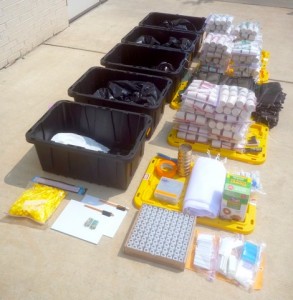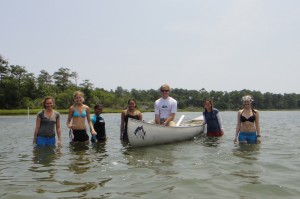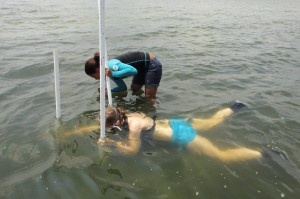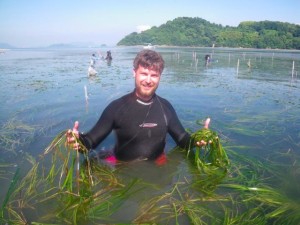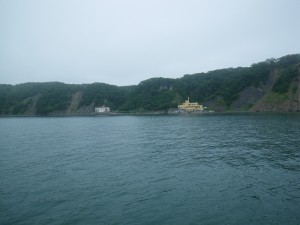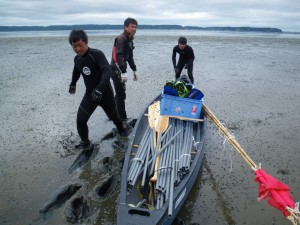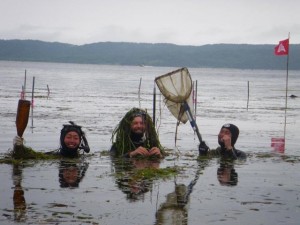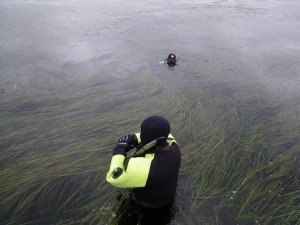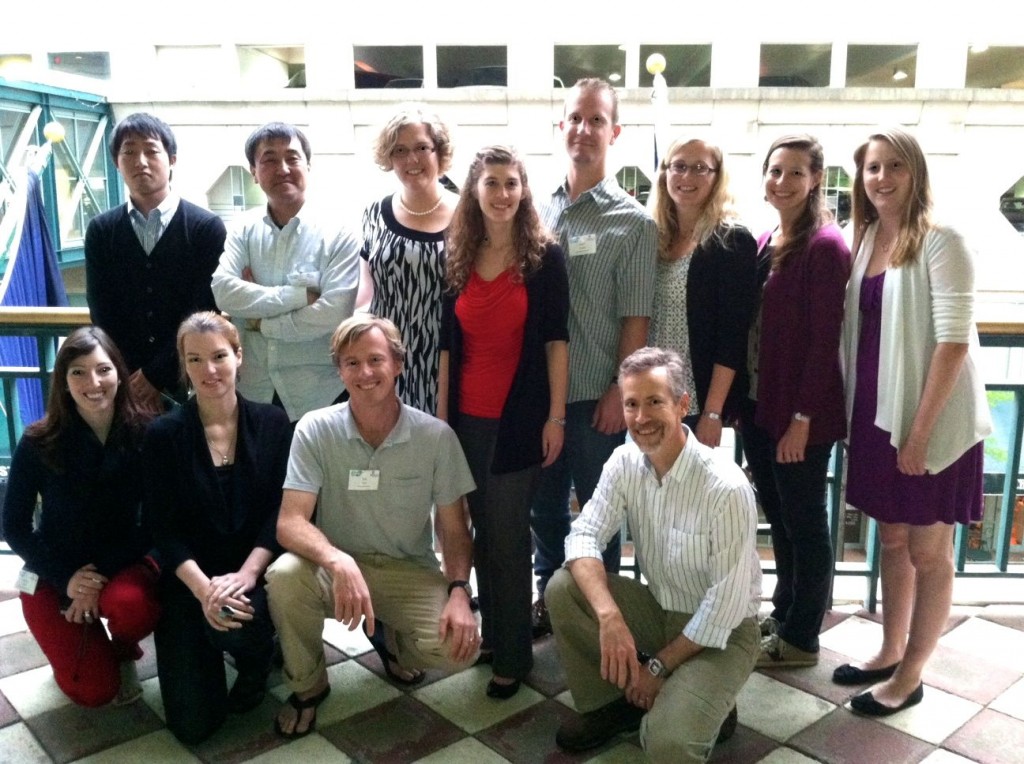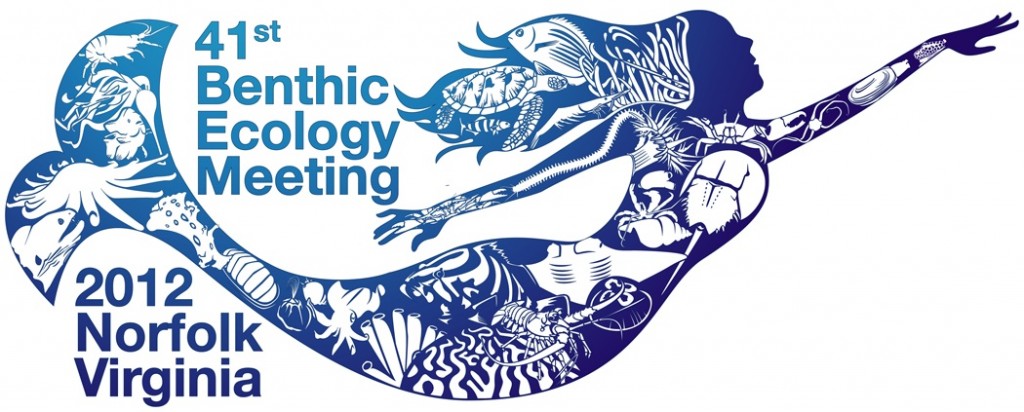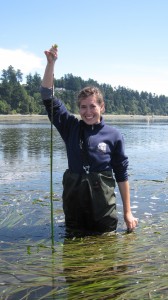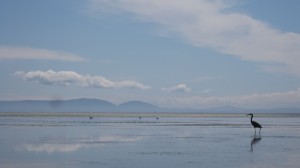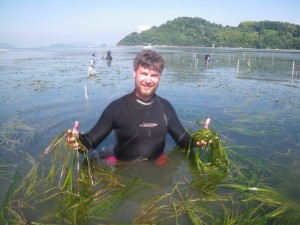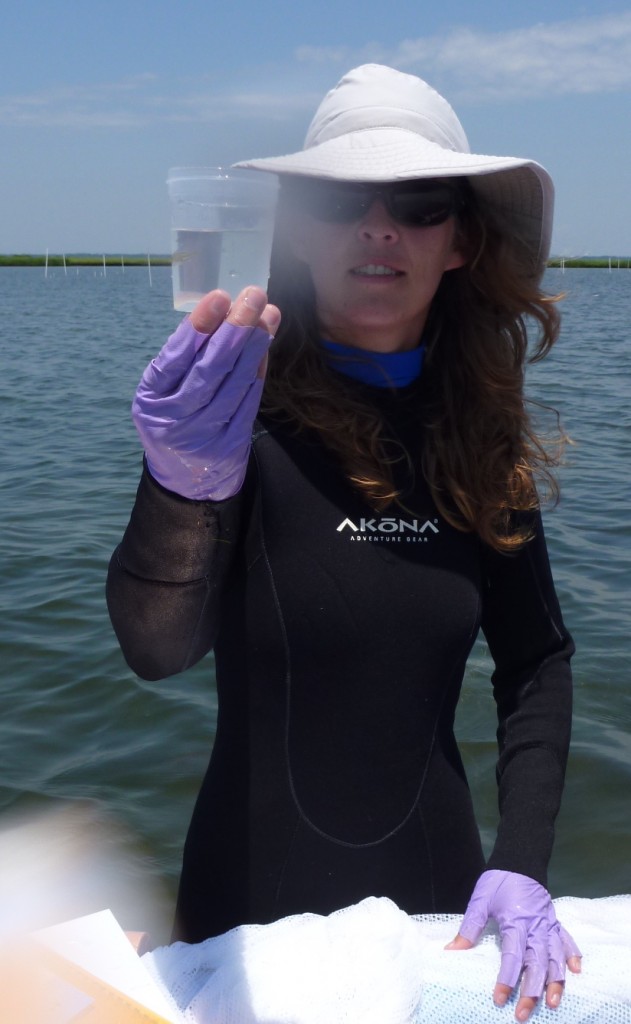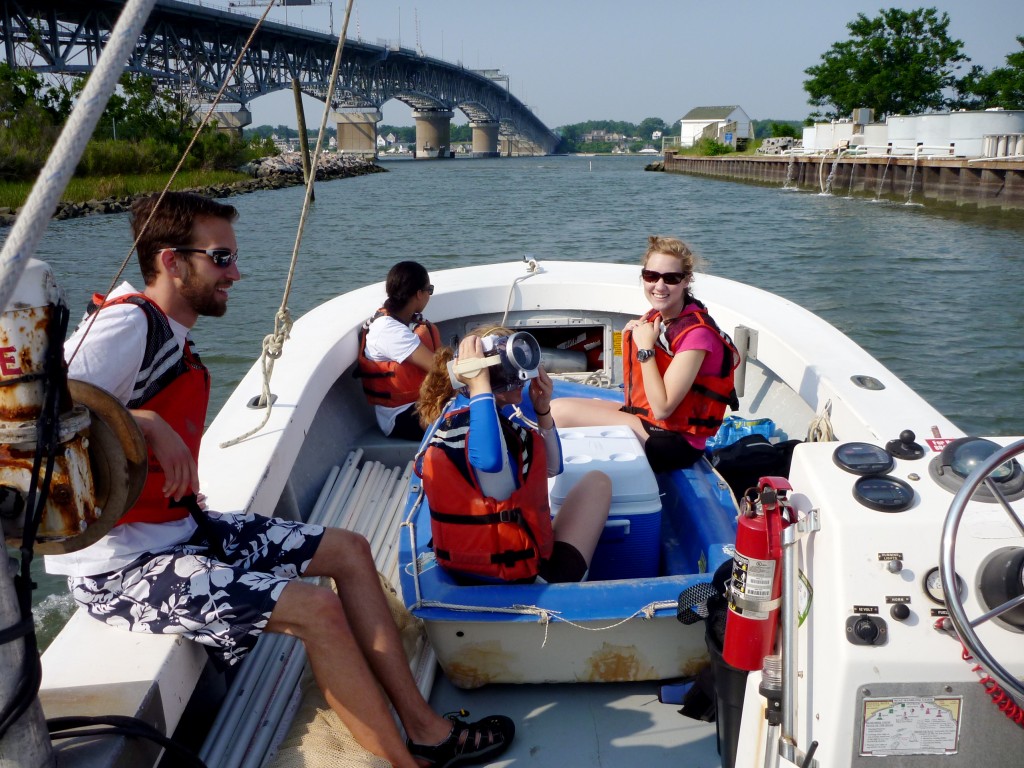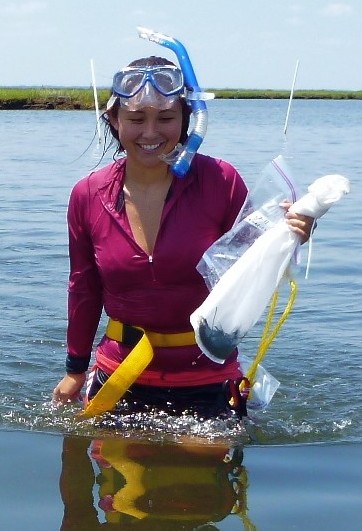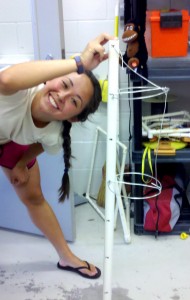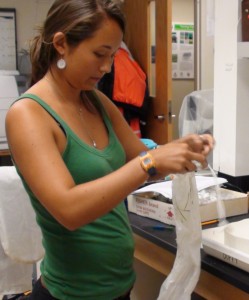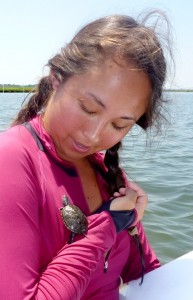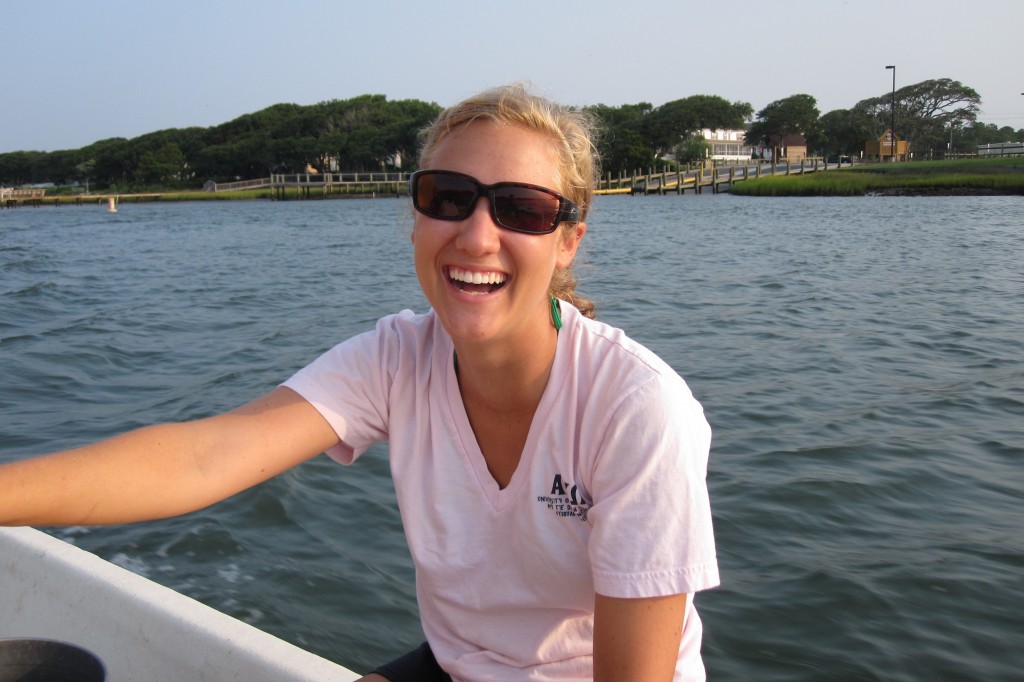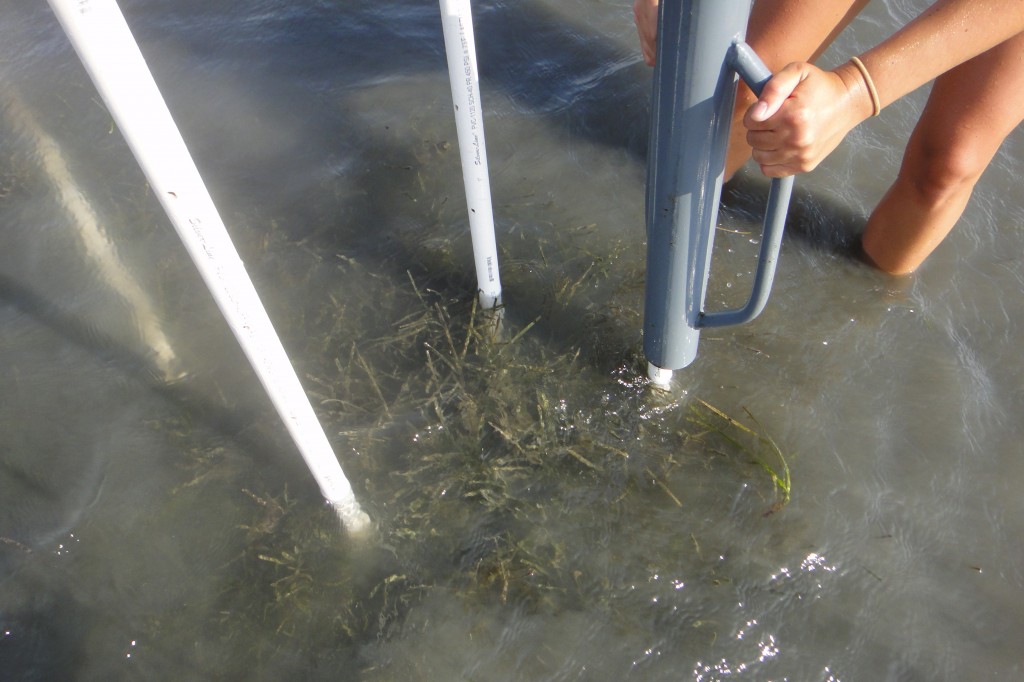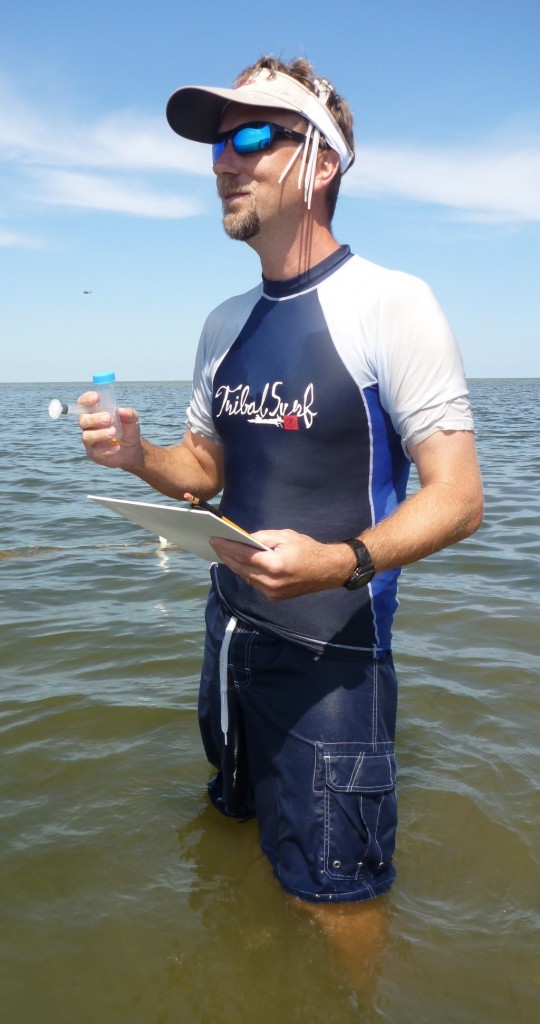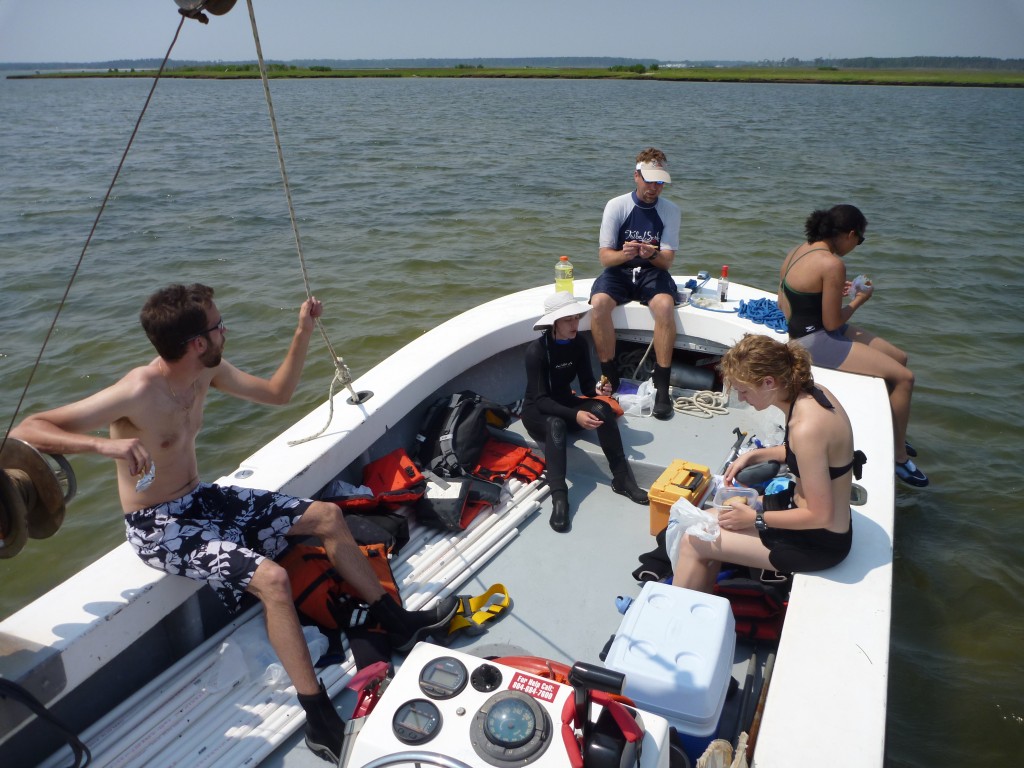Thowback Thursday – Setting the Stage
Working with a large, global network of collaborators poses unique opportunities — as well as challenges. Before ZEN’s parallel experiments could start at the 15 widely scattered partner sites in 2011, the VIMS team had to purchase, fabricate, assemble, package, and ship the experimental materials to the sites located throughout the northern hemisphere. That summer we shipped out up to 6 crates and over 500 lbs of gear per site (that’s almost 3.8 tons total!). There was a lot to be done before we could pull on the dive booties and plunge into the water at our own site! For summer of 2014 the focus is on rigorous, controlled surveys and smaller scale experiments, which has the added benefit of less international shipping!
A swim down memory lane
by Pamela Reynolds (ZEN coordinator)
The past several months we’ve been entrenched in finishing processing the experimental samples, analyzing data and writing up the results. This is a big switch from our constantly on the go routine during field season, and gives us time to reflect on what an amazing past two years we’ve had with ZEN. In that vein, I’ve dug up two pre-blog posts, quick little snippets I wrote back in the summer of 2011 before we launched the ZENscience.org website.
August 2011: Fieldwork Happens
Out in the field, the one thing I dread most isn’t encountering sharks in the murky water, seeing lightning streak overhead, or being pursued by voracious horseflies. Nope – it’s Murphy’s Law. We’ve all experienced it. A perfectly planned experimental setup can go from a well rehearsed orchestra to utter cacophony in a split second simply because someone forgot to bring scissors or dropped the ruler overboard, or a rogue wave made off with a pencil.
In our case, after placing and pounding 320 poles in the water we realized that our once lovely Zostera bed is now overgrown with Ruppia, a different type of seagrass. In our defense, the seagrass in the clearer water near the approach to the site was, in fact, Zostera. Murphy rears his ugly head, once again. How to deal with the mishap? Remove the poles, all 320 of them, call a few colleagues to find a new site, borrow a boat, and start over. This time everyone knew the drill and the setup went exceedingly smoothly. And, in the process we all learned how to distinguish the three local types of seagrass (Zostera, Ruppia, Halodule) by touch alone in the murky water. Turning Murphy into an educational experience – now that’s science! Having a team of graduate and undergraduate students who keep smiling? Priceless.
[Update: While I still despise coming up short on cable ties in the field, getting caught out on the water during a thunderstorm has quickly risen to fear #1. See the "Science is electric" blog post from 2012 to find out why.]
April 2011: When it absolutely, positively has to be there overnight
In preparing for ZEN the VIMS team became well versed in navigating international shipping. One of the things we learned early on was that customs agents are often quite literal. For instance, “300 blocks of 120 mL hardened dental plaster” can be translated into medical equipment and is subject to high tariffs. Doesn’t matter that the plaster has already been hardened and can’t be used to make casts of someone’s teeth – it’s all in the product description. And being vague isn’t much help either. Some countries want to know the composite materials of a t-shirt or line items of every ingredient in the dog food we used as fish bait, while for others the phrase “for education/research, not for resale” is sufficient. We are expecting that to some extent each country will have unique mesograzer assemblages and ecological interactions – why should we assume their import/export process to be the same?
[Update: I wrote this after a week of playing phone tag and emailing with shipping and customs agents to get our packages cleared and on their way to our international partners. Ultimately everything went through and there were no major delays or disruption of our partners' field schedules. Lesson learned? Leave at least a 3 week shipping allowance for international projects. And, keep UPS on speed dial!]
First Seagrass to see the light (part 2)
by Matt Whalen (VIMS, PhD student at UC Davis)
As I was gearing up for this year’s ZEN experiment in Bodega Bay, CA, I realized that I never finished my story from last year’s experiments in Japan. (Where does all the time go?) Hopefully this belated entry will be a nice way to kick off the 2012 ZEN season.
“Banzai, banzai, banzai!” was one of the first things I heard as my father and I watched the sun rise over the top of Mt. Fuji. It was a long journey—especially if you count my childhood memories of my father’s stories of Japan and his promise that we would one day climb to the top of the iconic mountain—but it was well worth it. There is a saying that goes something like, “You would be a fool not to climb Mt. Fuji, but you would be an even bigger fool to do it twice.” Well, my momma didn’t raise no fool. I really enjoyed that hike and I’m proud to have completed it with my dad, who was only a year out of knee replacement surgery, but the mile-long conga line of hikers ascending just before sunrise made me wish for the relative isolation of many U.S. National Park peaks. This side trip with my dad marked a transition between ZEN experiments and the halfway point in my journey to Japan.
Up north, to the land of Sapporo and snow
The next stage of my ZEN adventure took me to the northern island of Hokkaido, which is far less populous than the ‘main island’ of Honshu and home to the large city and brewery of Sapporo. I was immediately struck at how different this place looked compared to Hiroshima. The architecture was more rustic and functional; the Japanese-style tile roofs of the south gave way to A-frame metallic roofs in Hokkaido with increased seasonality and snow fall in the north. The countryside was also more bucolic in a western sense, with acres of cattle pasture mixed with stretches of corn and soy. It actually bore a striking resemblance to parts of Virginia, where my ZEN adventure began.
My new digs were at the Akkeshi Marine Station just outside of the important fishing town of Akkeshi. Seated at the base of steep cliffs, the laboratory, dormitory, and flagship research vessel were the only manmade structures in sight for a large stretch of the coastline. The coast here bends inward forming the large Akkeshi Bay. On clear mornings, I could easily see the other side of the bay and wisps of inland mountains further in the distance. The bay leads to Akkeshi town, ending in the narrow entrance to an estuary that is nearly as large as the bay itself.
Because it is almost completely enclosed, this estuary is referred to as a lake (Akkeshiko), but it is influenced by the tides throughout its extent and freshwater input comes largely from a single river. The lake is famous for its oysters and, more recently, Manila clams. More importantly for me, it has amazing meadows of seagrass. Nearly the entire estuary is covered with eelgrass whose leaves can grow over two meters in length (that’s over 6 feet!). When boating from one side of the lake to the other, it is necessary to stop and throw the motor in reverse every few hundred meters because the prop gets tangled in seagrass. On the plus side, with each subsequent field trip, we created a channel of sorts from all the lawn mowing and were able to minimize our impacts by following it all the way to our field site.
Unexpected challenges
For this node of the ZEN network, we faced a few challenges. The first challenge was the commute, which either involved a mowing expedition though the eelgrass meadow in a small motorboat or a half-hour drive to the far side of the lake where canoes could be launched in knee deep mud. This later choice was substantially slower but the drive took us through some gorgeous woods where we were ever vigilant for brown bears, which were often seen in those parts (not by any of us, fortunately or unfortunately!). If the potential threat of bears wasn’t enough to hurry us into the water, the clouds of mosquitoes surely helped us shave off a few minutes from the commute. I leave Virginia to fly halfway around the world and still found myself chased by the winged menaces!
The second challenge was the physical labor involved with field work in such tall eelgrass. Our site was fairly deep, such that at low tide the water came up to just above my waist. With eelgrass well over a meter tall, this made movement between plots as slow as molasses and reduced visibility to the front of our dive masks. I’m used to working in low visibility water in Virginia, but the ribbon-like eelgrass tangling everything was a new beast entirely. We were constantly brushing eelgrass out of our faces while surveying or sampling. And, when we came up for air, we often had wads of grass tugging our snorkels out of our mouths and “Cousin It” inspired eelgrass hairdos. Needless to say, we had to take great care to not rip the eelgrass from the inside of plots or brush off the very epiphytes we were aiming to quantify.
Never judge a jelly by its size
The final challenge made for one of my more memorable and culturally engaging experiences during my time in Japan. It concerned an eelgrass critter that had also visited me on occasion in Hiroshima, a small jelly that densely occupied the ZEN site in Lake Akkeshi. They pack a pretty mild punch (it wouldn’t come close to a box jelly), but when you get stung repeatedly it can take a toll. I experienced some of the pain in Hiroshima, a sharp sting and a long-lasting dull ache, but I wasn’t prepared for Lake Akkeshi.
We were finishing up some work on the weekend, so travel to the field site required both car and canoe. All was going smoothly, my Japanese collaborators and I by this point worked like a well oiled machine. That is, until I unintentionally swallowed some water stuck in my snorkel. Intense stinging in my mouth – that’s what I remember first. I spat and spat, but the stinging did not go away. Next my esophagus was on fire, and then my lower back and most of my joints began to ache. It was a deep ache, down to the bones, that made it hard to move or even think. I had swallowed part of a tiny jelly!
Luckily, I was surrounded by my new friends who loaded me back into the canoe and took me to shore. It took multiple canoe trips to get all the gear and people back to shore so I had to wait on the mudflat in between trips, still in my wetsuit since the mosquitoes were too bad to do anything else. Foundering in the mud with the stinging pain reaching a new peak, I vaguely remember hoping that this was not my day to finally see a brown bear. How I must have looked like an injured seal, covered in dark neoprene and writing in the mud! The decision was made to take me to the hospital, to which I couldn’t object by this time. I was largely incapacitated.
It was quite a while before we made it to the hospital, but I am happy to say that the experience was relatively easy. They had no problem treating me without my passport, and Dr. Hori (the project leader in Hiroshima) stayed with me to translate. To be honest, there was not much treatment that could be offered, although I was given some medicine to ease the pain. I was sent home with a goody bag of prescriptions that I needed more help translating, but I remained restless with pain. It took me another full day to recover completely. On Monday, I returned to the hospital to pay my bill, which was surprisingly modest. Luckily, after a handful of awkward and borderline comical exchanges about worker’s compensation back in the US, I was reimbursed in full. Being a marine ecologist does has its hazards, but I can’t think of anything else I’d rather do.
Jellyfishing in Japan, a short movie made by Matt Whalen based on his encounters with jellies in Japan.
The beauty of it all
All in all, ZEN in Hokkaido was an amazing experience. The eelgrass system there is so full of life. When viewed underwater, the meadow looks more like a forest and, if you are patient and a little lucky, many of the creatures that thrive under the canopy come into view. Small mysid ‘shrimp’ are very abundant here and seem to be important grazers on algae that grow on eelgrass leaves. There are also many abundant species of fish that presumably eat a lot of those mysids and other small grazers. And, of course, there are the jellies. They are actually quite beautiful when you don’t have thousands of nematocysts (their harpoon-like stingers) firing into your tissues!
Mysids on Eelgrass Akkeshi, a short movie by Matt Whalen.
I am so thankful for the opportunity to be a member of the ZEN Japan team during 2011. The country and its people left many lasting impressions on me, and I yearn to go back. Hopefully now that I am based on the West Coast of the USA I will have more opportunities to collaborate with the colleagues and friends I made on my adventure. There are two graduate students traveling to Japan this summer to participate in round two of the Zostera Experimental Network (look for their posts from Japan this summer!) and I hope to live vicariously through them as they travel and conduct experiments. I will be keeping up with their stories from Bodega Bay, CA, where our excellent team has just finished installing a major component of this year’s experiment. I can’t wait to hear about how things go at the other sites and to make more ZEN memories this summer. Dewa mata!
ZEN at the 2012 Benthic Ecology Meeting
The Zostera Experimental Network (ZEN) team formally emerged into public view for the first time at the Benthic Ecology Meeting this past week in Norfolk, Virginia. ZEN coordinator Dr. Pamela Reynolds (top center in the photo, in red) presented a first look at the results of our 2011 experiment evaluating the relative importance of grazing, nutrient loading, and abiotic forcing on dynamics of eelgrass (Zostera marina) communities across the Northern Hemisphere.
ZEN had representation from several of our 15 global sites, and a diverse group of PIs, grad students and undergrads, at BEM this year. These included teams from northern Japan (PI Massa Nakaoka and grad student Kyosuke Momota), Quebec (graduate students Julie Lemieux and Laetitia Joseph), Massachusetts (PI James Douglass), North Carolina (PI Erik Sotka, grad students Rachel Gittman and Nicole Kollars, technicians Danielle Abbey and Alyssa Popowich), and Virginia (Emmett Duffy, Pamela Reynolds, Paul Richardson).
The abstract of Pamela’s presentation:
A comparative-experimental approach reveals complex forcing among bottom-up and top-down processes in seagrass communities across the Northern Hemisphere
Pamela L. Reynolds (1); Emmett Duffy (1); Christoffer Boström (2); James Coyer (3); Mathieu Cusson (4); James Douglass (5); Johan Eklöf (6); Aschwin Engelen (7); Klemens Eriksson (3); Stein Fredriksen (8); Lars Gamfeldt (6); Masakazu Hori (9); Kevin Hovel (10); Katrin Iken (11); Per-Olav Moksnes (6); Masahiro Nakaoka (12); Mary O’Connor (13); Jeanine Olsen (3); Paul Richardson (1); Jennifer Ruesink (14); Erik Sotka (15); Jay Stachowicz (16); Jonas Thormar (8)
(1) Virginia Institute of Marine Science, (2) Åbo Akademi University, (3) University of Gronigen, (4) Université du Québec à Chicoutimi, (5) Northeastern University, (6) University of Gothenburg, (7) Universidade do Algarve, (8) University of Oslo, (9) Fisheries Research Agency, Japan, (10) San Diego State University, (11) University of Alaska Fairbanks, (12) Hokkaido University, (13) University of British Columbia, (14) University of Washington, (15) College of Charleston, (16) University of California Davis
Two fundamental challenges to prediction in ecology are complexity and idiosyncrasy. How do we evaluate the importance and generality of multiple, interacting factors in mediating ecological structure and processes? One promising way forward is the comparative-experimental approach, integrating standardized experiments with observational data. In summer 2011 the Zostera Experimental Network (ZEN), a collaboration among ecologists across 15 Northern Hemisphere sites, initiated parallel field experiments exploring bottom-up and top-down control in eelgrass (Zostera marina) communities. Eelgrass is among the most widespread marine plants, forming ecologically and economically important but threatened coastal habitats. We factorially added nutrients and excluded small crustaceans (mesograzers) using a degradable chemical deterrent for four weeks, and measured responses of associated plant and animal communities. As expected, results varied strongly across the global range. Our cage-free deterrent strongly reduced crustacean grazers; at several sites grazer exclusion released blooms of epiphytic algae and/or sessile invertebrates. In Chesapeake Bay, these blooms reduced eelgrass biomass after eight weeks, demonstrating mutualistic dependence between eelgrass and mesograzers. Surprisingly, nutrient addition had little effect on epiphytes, except in Massachusetts and Sweden where grazers are suppressed by mesopredators. Ongoing research is analyzing the relative influence of grazer diversity and environmental forcing in mediating these processes.
Analysis of the 2011 experiments is still under way–even as we swing into high gear for planning the 2012 experiment. We will be presenting the complete results of the 2011 experiment at the Ecological Society of America meeting in Portland (August 2012) and the 47th European Marine Biology Symposium in Arendal, Norway (September 2012). We hope to see you at one or another of these events!
Typical day at the ZEN British Columbia field site
by Carolyn Prentice (Univ. British Columbia undergraduate at ZEN Vancouver, British Columbia Site)
My experience working on the ZEN project in Dr. Mary O’Connor’s lab this past summer was simply fantastic. It was great to have a summer job that I was really passionate about; anytime anyone asked me what I was doing for the summer, they were in for more than just a one-sentence answer! It was also great to share the experience with many other passionate biologists; we had an amazing group of workers and volunteers. Even when it was rainy and windy and our hands were numb, we knew we were lucky to be doing what we were doing! I am grateful to have had such an amazing opportunity, especially as an undergraduate and working on the ZEN project has certainly inspired me to continue studying the fascinating communities that inhabit Zostera marina beds. I am also excited to see the results of the ZEN projects from all of the different sites!
A typical day for the crew at the ZEN B.C. site:
1. Pile into the U.B.C. Zoology van with equipment and keen volunteers.
2. Arrive at the field site, put on (leaky) chest waders and sun hats or rain jackets (typically the latter).
3. Head down the 300 or so stairs to the beach, pass all of the locals getting their daily exercise and wearing ‘what are you guys up to’ looks on their faces.
4. Head out onto the mud flats, try not to stop moving or risk getting stuck in the really sticky mud.
5. Go about whatever task we had set out to do that day. Meanwhile, enjoy the beautiful scenery – the nearby Gulf Islands, the B.C. Ferries sailing across the Straight of Georgia, and hundreds of foraging herons.
6. Walk back up the 300 or so stairs (great exercise!)
7. Empty the leaky waders.
8. Go to Tim Horton’s to get iced caps or hot chocolates (typically the latter) before heading back to U.B.C.
9. Go home feeling like the luckiest people in the world!
First grass to see the light: ZEN in Japan
by Matt Whalen (VIMS, UC Davis graduate student)
I was excited to participate in the ZEN project because of the preliminary work I did for my Master’s research under Dr. Emmett Duffy at the Virginia Institute of Marine Science (VIMS) to test the methods in seagrass. I was also excited for the chance to get up close and personal with eelgrass (Zostera marina) in different parts of the world. I had visited eelgrass beds in Boston, Massachusetts, Bodega Bay, California, and Vancouver, Canada while visiting grad schools, and played around in tropical seagrasses in Florida while helping out with a seahorse research project a few years ago, but the bulk of my research experience in seagrass was focused on the lower Chesapeake Bay. When I found out that I would be traveling to Japan to work on not one but two of the ZEN experiments, I felt like a boyhood dream had come true. Sappy, but it’s 100% accurate. My father lived in Japan for a number of years while he was in the navy, and growing up I heard a lot of stories about his time there that romanticized the whole thing for me. He even promised me (around the time I started tying my own shoes) that we would travel to Japan together one day to climb Mt. Fuji.
The timing of the trip could not have been more perfect. At the conclusion of my Master’s degree at VIMS and before beginning my PhD at UC Davis. I spent a month and a half in the land of the rising sun. My time was split between Hiroshima Prefecture, Tokyo and surrounding areas, and the northern island of Hokkaido. No amount of Japanese anime (my favorite series being Cowboy Bebop and my most recently viewed film a Japanese rendition of the Little Mermaid named Ponyo) could have prepared me for how amazing this trip would be. My first impressions were actually in the airport and during the flight. I had scored direct flights from Washington, D.C. to Tokyo and I flew with ANA (All Nippon Airways)…“Nippon” and “Nihon” are Japanese (Nihongo) for Japan, and I’m not sure how “Japan” came into use. As is often the case (for me, anyway), international flights are far superior to domestic US flights, and ANA exceeded anything I had experienced before (I’ll let the better-traveled out there decide whether ANA or international flights generally are superior).
I made a quick list of why these international flights were awesome: Continue Reading
Science – it’s electric!
By Pamela Reynolds (VIMS; ZEN Coordinator) with contributions from Paul Richardson and Akela Kuwahara
There are few times in my life that I can honestly say that I was terrified. Feeling the Loma Prieta earthquake in ’89, (nearly) tripping over a cottonmouth snake, taking my qualifying exams all stand out. So does the 28th of June in 2011.
It started out as a normal day, or at least as normal as a day of fieldwork can go at the ZEN site in Virginia. It began with the usual flurry of activity in the early morning packing the experimental equipment and loading the boat, checking the associated weather websites and filling out the float plan, slathering on sunscreen and pulling on life jackets and dive booties. It was a typical hot, humid, and sunny summer field day in coastal Virginia.
As is customary, when we arrived at the site Captain Paul cranked up the VHF radio to the weather channel and its droning computerized voice began babbling in the background. We set anchor, grabbed our masks and associated collecting gear, hopped into the water, and got to work. We were collecting seagrass shoots to measure growth rates, which involved a lot of swimming and diving among our experimental plots in what we affectionately called the ZEN Pole Garden. On about plot number 22, half way through our collections shortly after 3 o’clock in the afternoon, it started. That dreaded cacophony over the VHF radio followed by the ominous blaring of the weather alarm and the warning statement that can mean only one thing – storm!
I never used to be afraid of lightning. I actually found it to be beautiful, exciting even; an awesome display of the raw power of nature ripping the sky above. My sentiments have changed. Continue Reading
A summer of adventure
By Akela Kuwahara, VIMS REU student summer 2011 (Humboldt State University)
Last week I earned my Invertebrate Zoology team at Humboldt State University 10 extra credit points for successfully identifying a gammaridean and caprellid amphipod, a mysid shrimp, and several Palmonetesshrimps! How, you ask? One word: ZEN.
This past summer I was in the REU program at VIMS working with Dr. Duffy’s Marine Biodiversity Lab. The ZEN project had just begun when I arrived in Virginia and I quickly set to work making experimental equipment and processing seagrass samples. Coastal Virginia looks nothing like the rocky California Coast where I currently go to school at Humboldt State University, nor like where I grew up on the Big Island of Hawaii.
I have had few experiences as enriching, educational, and career-focusing as my internship with the VIMS ZEN team. I had an up-close encounter with a juvenile terrapin who tried to nest in my hair, and an encounter with a sea nettle that wrapped my leg in a less than tender embrace. I became an expert at pouring cups of wet plaster, identifying a severed head or lone backside of the tiny amphipod Gammarus mucronatus, distinguishing between seagrasses Ruppia and Zostera, doing the sting-ray-shuffle, writing international UPS labels in the nick of time, and so much more.
Sadly, since my time at VIMS has ended, these skills have been poorly utilized. They have, however, given me a better understanding of marine ecology and the functioning of seagrass habitats, and they’ve earned me 10 extra credit points in Invertebrate Zoology! Emmett Duffy’s lab at VIMS is a craftily chosen group of people who have collectively helped to steer my interest in graduate studies towards subtidal ecosystems and their global presence and impact. I can’t wait to hear about where the ZEN is headed, and the progress that it has made. It was a summer well spent.
Photos by JE Duffy, PL Reynolds, JP Richardson
A ZEN-like beginning in North Carolina
By Megan Gyoerkoe, UNC Chapel Hill undergraduate student
One morning, bright and very early, the North Carolina ZEN team packed up the truck and with all the necessary materials for the initial set up of all 40 experimental plots for our experiment. We arrived at our field site behind the Pine Knoll Shores Aquarium and the weather was absolutely beautiful, sunny and warm but with a cool breeze. The tide was calm and the Zostera seagrass beds were vast and lush. After briefly meeting with the aquarium staff our group got started right away, driving the 120+ poles needed to mark the experimental plots into the sediment. About half way through Pamela began to check some of the plots to make sure they had enough Zostera (we were aiming for a minimum of 80% cover). As it turns out what we thought were lush beds of Zostera were actually composed mainly of a different type of seagrass – Ruppia! You can understand that this is a problem given that we are working on the Zostera Experimental Network (ZEN) and not, well REN!
We had spent all morning driving poles into the sediment only to discover that we had been deceived by the seagrass. In disbelief that we could have made such a mistake, we checked and double-checked the plots. Then we went on an extensive Zostera hunt, searching endlessly for a hint of a healthy Zostera bed, swimming through the seagrass even under the threat of being hit in the face by jumping mullets! Turns out it was all in vain and it was back to the drawing board for the ZEN-NC site. What had been an extensive Zostera bed two years before had been replaced almost entirely by Ruppia and some Halodule seagrasses. We spent hours pounding in the poles only to pull them back up the next day.
Fortunately, Pamela, Erik and Rachel were able to work out the logistics for us to work at a new site nearby in Middle Marsh that was actually filled with beautiful, lush Zostera. Even though we had to re-set all of the poles, it turned out to be a wonderful, protected site that was a pleasure to work in.
Field research is definitely a category on its own; it is pleasantly unpredictable, entertaining, exciting and occasionally slightly torturous. Continue Reading
The ZEN Factory
By Paul Richardson, VIMS Marine Biodiversity Lab Manager
As Emmett’s lab manager in the Marine Biodiversity Lab at VIMS for the past 10 years there’s rarely been a dull moment. There is such an eclectic range of duties with this job that sometimes it’s hard to know what will come next. One day I may be driving a research vessel to field sites were we snorkel to collect samples in the Chesapeake Bay, the next I’m doing data analysis, or building materials for a mesocosm or field experiment, talking to a high school marine biology class, ordering lab supplies, or explaining to the woman at Wal-Mart that I really am buying all of their lingerie bags and knee high, queen sized, reinforced toe stockings for the purpose of science! The Zostera Experimental Network (ZEN) project has added yet more varied activities to the list. Never before have we conducted such an expansive project coordinating with 14 other research groups from around the States and the world!
First I have to say that none of this would have been possible without the hard work of the crew: volunteers Kara Gadeken, Megan Gyoerkoe, Jack Hawkins, and John Ray; our REU intern Akela Kuwahara and others; and the VIMS crew of Emmett Duffy, Pamela Reynolds, Erin Ferer, Jon Lefcheck, Nathan Bowman, and Elizabeth Bush. Marine ecology is a team sport and this crew knows how to play the game. Thanks! Also, I’m amazed to learn that it appears that all of the ZEN partners not only attempted but finished their experiments as well. As a first step, last winter we held a conference where representatives from all of the groups met in Williamsburg, VA to hash out a plan for the project. At this very productive meeting, it was great to meet all of the partners and certainly it was crucial to the success of the project. With Jim Grace’s seminars on structural equation modeling, Jim Thomas’ amphipod workshop, and all of the work sessions and other activities, the ZEN conference deserves its own dedicated post. As for me, after the meeting I worked with Emmett and Pamela to compute our materials needs, costs, vendors etc. for the network of ZEN experiments while also building on Matt Whalen’s work to formulate an ideal recipe and method for churning out the abundance of deterrent and control blocks that would be needed. I began conducting small field experiments to this end in the fall of 2010. In the spring after more trials we ultimately decided on a final mixture and we started churning them out. Continue Reading

